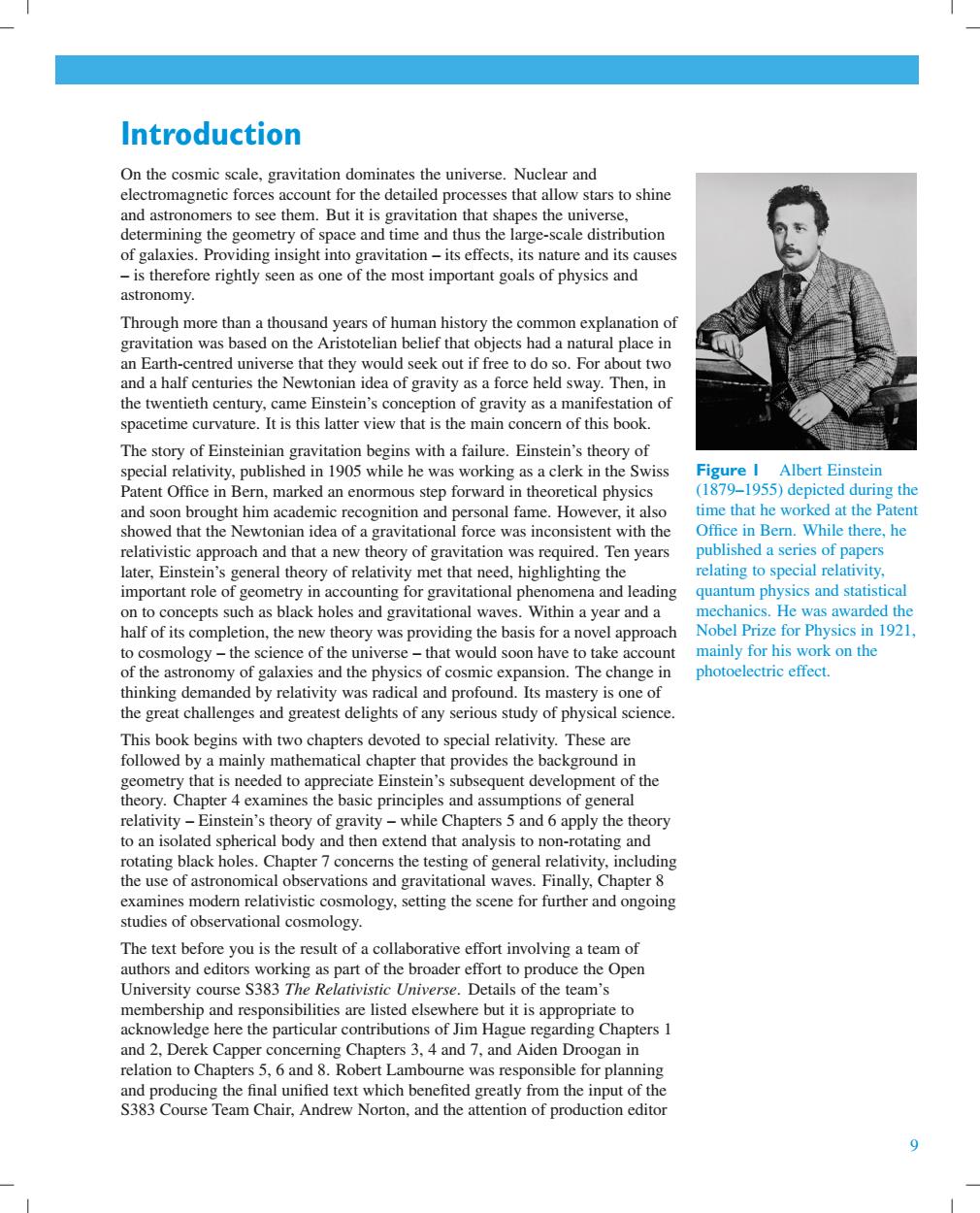
Introduction On the cosmic scale,gravitation dominates the universe.Nuclear and electromagnetic forces account for the detailed processes that allow stars to shine and astronomers to see them.But it is gravitation that shapes the universe, determining the geometry of space and time and thus the large-scale distribution of galaxies.Providing insight into gravitation-its effects,its nature and its causes -is therefore rightly seen as one of the most important goals of physics and astronomy Through more than a thousand years of human history the common explanation of gravitation was based on the Aristotelian belief that objects had a natural place in an Earth-centred universe that they would seek out if free to do so.For about two and a half centuries the Newtonian idea of gravity as a force held sway.Then,in the twentieth century,came Einstein's conception of gravity as a manifestation of spacetime curvature.It is this latter view that is the main concern of this book. The story of Einsteinian gravitation begins with a failure.Einstein's theory of special relativity,published in 1905 while he was working as a clerk in the Swiss Figure I Albert Einstein Patent Office in Bern,marked an enormous step forward in theoretical physics (1879-1955)depicted during the and soon brought him academic recognition and personal fame.However,it also time that he worked at the Patent showed that the Newtonian idea of a gravitational force was inconsistent with the Office in Bern.While there,he relativistic approach and that a new theory of gravitation was required.Ten years published a series of papers later,Einstein's general theory of relativity met that need,highlighting the relating to special relativity, important role of geometry in accounting for gravitational phenomena and leading quantum physics and statistical on to concepts such as black holes and gravitational waves.Within a year and a mechanics.He was awarded the half of its completion,the new theory was providing the basis for a novel approach Nobel Prize for Physics in 1921, to cosmology-the science of the universe-that would soon have to take account mainly for his work on the of the astronomy of galaxies and the physics of cosmic expansion.The change in photoelectric effect. thinking demanded by relativity was radical and profound.Its mastery is one of the great challenges and greatest delights of any serious study of physical science. This book begins with two chapters devoted to special relativity.These are followed by a mainly mathematical chapter that provides the background in geometry that is needed to appreciate Einstein's subsequent development of the theory.Chapter 4 examines the basic principles and assumptions of general relativity-Einstein's theory of gravity-while Chapters 5 and 6 apply the theory to an isolated spherical body and then extend that analysis to non-rotating and rotating black holes.Chapter 7 concerns the testing of general relativity,including the use of astronomical observations and gravitational waves.Finally,Chapter 8 examines modern relativistic cosmology,setting the scene for further and ongoing studies of observational cosmology. The text before you is the result of a collaborative effort involving a team of authors and editors working as part of the broader effort to produce the Open University course S383 The Relativistic Universe.Details of the team's membership and responsibilities are listed elsewhere but it is appropriate to acknowledge here the particular contributions of Jim Hague regarding Chapters 1 and 2,Derek Capper concerning Chapters 3,4 and 7,and Aiden Droogan in relation to Chapters 5,6 and 8.Robert Lambourne was responsible for planning and producing the final unified text which benefited greatly from the input of the S383 Course Team Chair,Andrew Norton,and the attention of production editor
Introduction On the cosmic scale, gravitation dominates the universe. Nuclear and electromagnetic forces account for the detailed processes that allow stars to shine and astronomers to see them. But it is gravitation that shapes the universe, determining the geometry of space and time and thus the large-scale distribution of galaxies. Providing insight into gravitation – its effects, its nature and its causes – is therefore rightly seen as one of the most important goals of physics and astronomy. Through more than a thousand years of human history the common explanation of gravitation was based on the Aristotelian belief that objects had a natural place in an Earth-centred universe that they would seek out if free to do so. For about two and a half centuries the Newtonian idea of gravity as a force held sway. Then, in the twentieth century, came Einstein’s conception of gravity as a manifestation of spacetime curvature. It is this latter view that is the main concern of this book. Figure 1 Albert Einstein (1879–1955) depicted during the time that he worked at the Patent Office in Bern. While there, he published a series of papers relating to special relativity, quantum physics and statistical mechanics. He was awarded the Nobel Prize for Physics in 1921, mainly for his work on the photoelectric effect. The story of Einsteinian gravitation begins with a failure. Einstein’s theory of special relativity, published in 1905 while he was working as a clerk in the Swiss Patent Office in Bern, marked an enormous step forward in theoretical physics and soon brought him academic recognition and personal fame. However, it also showed that the Newtonian idea of a gravitational force was inconsistent with the relativistic approach and that a new theory of gravitation was required. Ten years later, Einstein’s general theory of relativity met that need, highlighting the important role of geometry in accounting for gravitational phenomena and leading on to concepts such as black holes and gravitational waves. Within a year and a half of its completion, the new theory was providing the basis for a novel approach to cosmology – the science of the universe – that would soon have to take account of the astronomy of galaxies and the physics of cosmic expansion. The change in thinking demanded by relativity was radical and profound. Its mastery is one of the great challenges and greatest delights of any serious study of physical science. This book begins with two chapters devoted to special relativity. These are followed by a mainly mathematical chapter that provides the background in geometry that is needed to appreciate Einstein’s subsequent development of the theory. Chapter 4 examines the basic principles and assumptions of general relativity – Einstein’s theory of gravity – while Chapters 5 and 6 apply the theory to an isolated spherical body and then extend that analysis to non-rotating and rotating black holes. Chapter 7 concerns the testing of general relativity, including the use of astronomical observations and gravitational waves. Finally, Chapter 8 examines modern relativistic cosmology, setting the scene for further and ongoing studies of observational cosmology. The text before you is the result of a collaborative effort involving a team of authors and editors working as part of the broader effort to produce the Open University course S383 The Relativistic Universe. Details of the team’s membership and responsibilities are listed elsewhere but it is appropriate to acknowledge here the particular contributions of Jim Hague regarding Chapters 1 and 2, Derek Capper concerning Chapters 3, 4 and 7, and Aiden Droogan in relation to Chapters 5,6and 8. Robert Lambourne was responsible for planning and producing the final unified text which benefited greatly from the input of the S383 Course Team Chair, Andrew Norton, and the attention of production editor 9
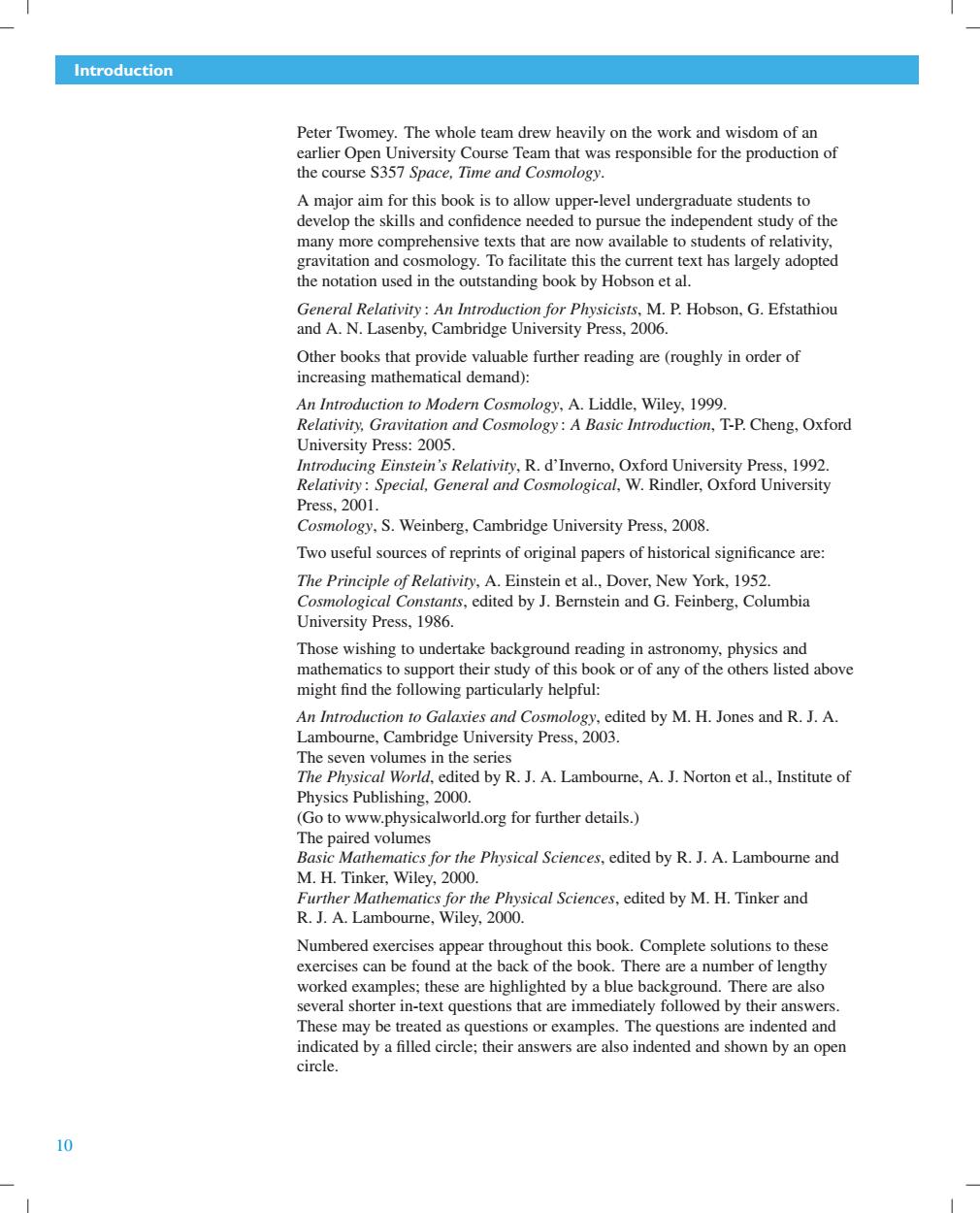
Introduction Peter Twomey.The whole team drew heavily on the work and wisdom of an earlier Open University Course Team that was responsible for the production of the course S357 Space,Time and Cosmology. A major aim for this book is to allow upper-level undergraduate students to develop the skills and confidence needed to pursue the independent study of the many more comprehensive texts that are now available to students of relativity, gravitation and cosmology.To facilitate this the current text has largely adopted the notation used in the outstanding book by Hobson et al. General Relativity:An Introduction for Physicists,M.P.Hobson,G.Efstathiou and A.N.Lasenby,Cambridge University Press,2006. Other books that provide valuable further reading are(roughly in order of increasing mathematical demand): An Introduction to Modern Cosmology,A.Liddle,Wiley,1999. Relativity,Gravitation and Cosmology:A Basic Introduction,T-P.Cheng,Oxford University Press:2005. Introducing Einstein's Relativity,R.d'Inverno,Oxford University Press,1992. Relativity:Special,General and Cosmological,W.Rindler,Oxford University Press,2001. Cosmology,S.Weinberg,Cambridge University Press,2008. Two useful sources of reprints of original papers of historical significance are: The Principle of Relativity,A.Einstein et al.,Dover,New York,1952. Cosmological Constants,edited by J.Bernstein and G.Feinberg,Columbia University Press,1986. Those wishing to undertake background reading in astronomy,physics and mathematics to support their study of this book or of any of the others listed above might find the following particularly helpful: An Introduction to Galaxies and Cosmology,edited by M.H.Jones and R.J.A. Lambourne,Cambridge University Press,2003. The seven volumes in the series The Physical World,edited by R.J.A.Lambourne,A.J.Norton et al.,Institute of Physics Publishing,2000. (Go to www.physicalworld.org for further details.) The paired volumes Basic Mathematics for the Physical Sciences,edited by R.J.A.Lambourne and M.H.Tinker,Wiley,2000. Further Mathematics for the Physical Sciences,edited by M.H.Tinker and R.J.A.Lambourne,Wiley,2000. Numbered exercises appear throughout this book.Complete solutions to these exercises can be found at the back of the book.There are a number of lengthy worked examples;these are highlighted by a blue background.There are also several shorter in-text questions that are immediately followed by their answers. These may be treated as questions or examples.The questions are indented and indicated by a filled circle;their answers are also indented and shown by an open circle. 10
Introduction Peter Twomey. The whole team drew heavily on the work and wisdom of an earlier Open University Course Team that was responsible for the production of the course S357 Space, Time and Cosmology. A major aim for this book is to allow upper-level undergraduate students to develop the skills and confidence needed to pursue the independent study of the many more comprehensive texts that are now available to students of relativity, gravitation and cosmology. To facilitate this the current text has largely adopted the notation used in the outstanding book by Hobson et al. General Relativity : An Introduction for Physicists, M. P. Hobson, G. Efstathiou and A. N. Lasenby, Cambridge University Press, 2006. Other books that provide valuable further reading are (roughly in order of increasing mathematical demand): An Introduction to Modern Cosmology, A. Liddle, Wiley, 1999. Relativity, Gravitation and Cosmology : A Basic Introduction, T-P. Cheng, Oxford University Press: 2005. Introducing Einstein’s Relativity, R. d’Inverno, Oxford University Press, 1992. Relativity : Special, General and Cosmological, W. Rindler, Oxford University Press, 2001. Cosmology, S. Weinberg, Cambridge University Press, 2008. Two useful sources of reprints of original papers of historical significance are: The Principle of Relativity, A. Einstein et al., Dover, New York, 1952. Cosmological Constants, edited by J. Bernstein and G. Feinberg, Columbia University Press, 1986. Those wishing to undertake background reading in astronomy, physics and mathematics to support their study of this book or of any of the others listed above might find the following particularly helpful: An Introduction to Galaxies and Cosmology, edited by M. H. Jones and R. J. A. Lambourne, Cambridge University Press, 2003. The seven volumes in the series The Physical World, edited by R. J. A. Lambourne, A. J. Norton et al., Institute of Physics Publishing, 2000. (Go to www.physicalworld.org for further details.) The paired volumes Basic Mathematics for the Physical Sciences, edited by R. J. A. Lambourne and M. H. Tinker, Wiley, 2000. Further Mathematics for the Physical Sciences, edited by M. H. Tinker and R. J. A. Lambourne, Wiley, 2000. Numbered exercises appear throughout this book. Complete solutions to these exercises can be found at the back of the book. There are a number of lengthy worked examples; these are highlighted by a blue background. There are also several shorter in-text questions that are immediately followed by their answers. These may be treated as questions or examples. The questions are indented and indicated by a filled circle; their answers are also indented and shown by an open circle. 10
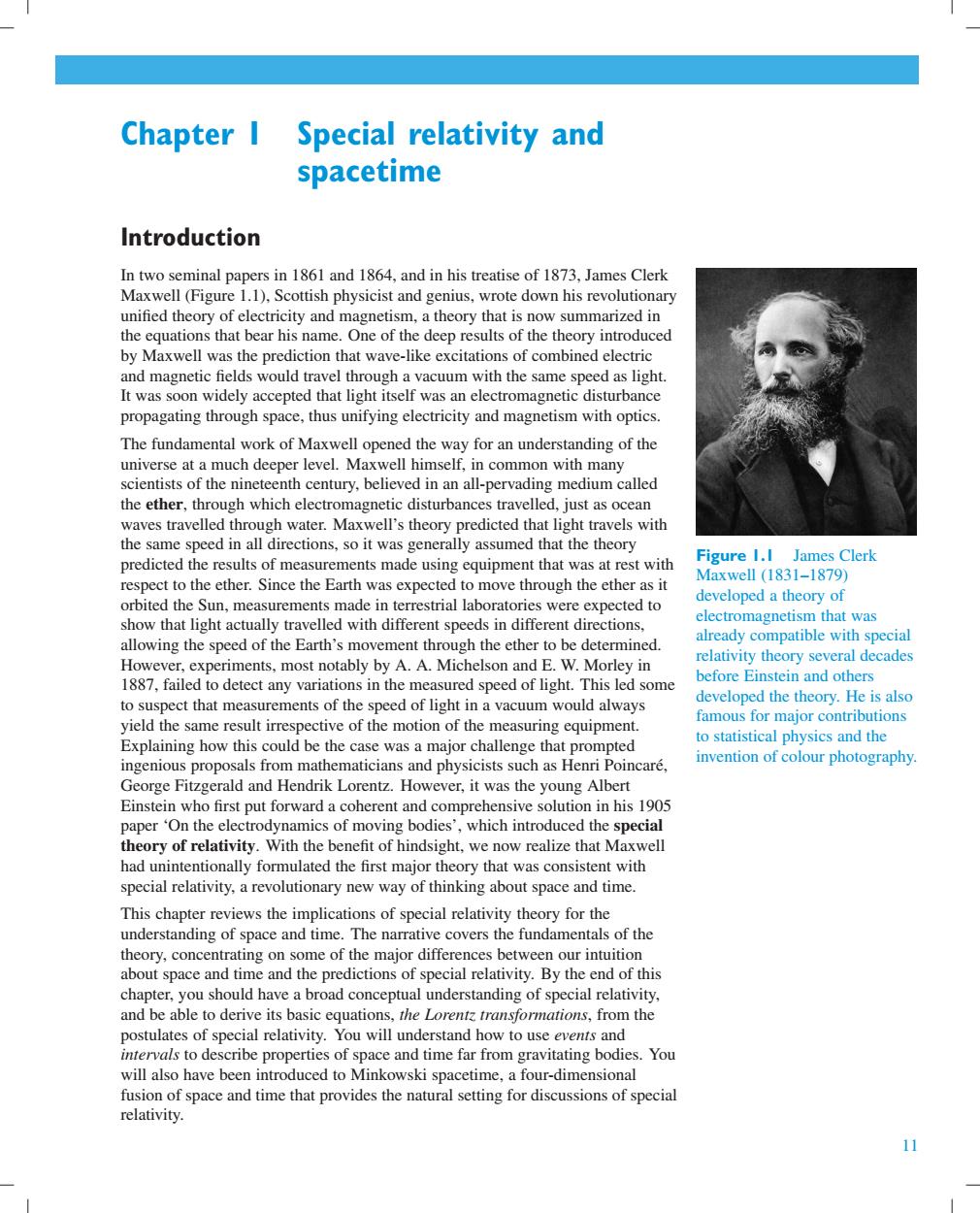
Chapter I Special relativity a and spacetime Introduction In two seminal papers in 1861 and 1864,and in his treatise of 1873,James Clerk Maxwell(Figure 1.1),Scottish physicist and genius,wrote down his revolutionary unified theory of electricity and magnetism,a theory that is now summarized in the equations that bear his name.One of the deep results of the theory introduced by Maxwell was the prediction that wave-like excitations of combined electric and magnetic fields would travel through a vacuum with the same speed as light. It was soon widely accepted that light itself was an electromagnetic disturbance propagating through space,thus unifying electricity and magnetism with optics. The fundamental work of Maxwell opened the way for an understanding of the universe at a much deeper level.Maxwell himself,in common with many scientists of the nineteenth century,believed in an all-pervading medium called the ether,through which electromagnetic disturbances travelled,just as ocean waves travelled through water.Maxwell's theory predicted that light travels with the same speed in all directions,so it was generally assumed that the theory predicted the results of measurements made using equipment that was at rest with Figure 1.I James Clerk Maxwell(1831-1879) respect to the ether.Since the Earth was expected to move through the ether as it orbited the Sun,measurements made in terrestrial laboratories were expected to developed a theory of show that light actually travelled with different speeds in different directions, electromagnetism that was allowing the speed of the Earth's movement through the ether to be determined. already compatible with special However,experiments,most notably by A.A.Michelson and E.W.Morley in relativity theory several decades 1887,failed to detect any variations in the measured speed of light.This led some before Einstein and others to suspect that measurements of the speed of light in a vacuum would always developed the theory.He is also yield the same result irrespective of the motion of the measuring equipment. famous for major contributions Explaining how this could be the case was a major challenge that prompted to statistical physics and the ingenious proposals from mathematicians and physicists such as Henri Poincare, invention of colour photography. George Fitzgerald and Hendrik Lorentz.However,it was the young Albert Einstein who first put forward a coherent and comprehensive solution in his 1905 paper 'On the electrodynamics of moving bodies',which introduced the special theory of relativity.With the benefit of hindsight,we now realize that Maxwell had unintentionally formulated the first major theory that was consistent with special relativity,a revolutionary new way of thinking about space and time. This chapter reviews the implications of special relativity theory for the understanding of space and time.The narrative covers the fundamentals of the theory,concentrating on some of the major differences between our intuition about space and time and the predictions of special relativity.By the end of this chapter,you should have a broad conceptual understanding of special relativity, and be able to derive its basic equations,the Lorentz transformations,from the postulates of special relativity.You will understand how to use events and intervals to describe properties of space and time far from gravitating bodies.You will also have been introduced to Minkowski spacetime,a four-dimensional fusion of space and time that provides the natural setting for discussions of special relativity. 11
Chapter 1 Special relativity and spacetime Introduction In two seminal papers in 1861 and 1864, and in his treatise of 1873, James Clerk Maxwell (Figure 1.1), Scottish physicist and genius, wrote down his revolutionary unified theory of electricity and magnetism, a theory that is now summarized in the equations that bear his name. One of the deep results of the theory introduced by Maxwell was the prediction that wave-like excitations of combined electric and magnetic fields would travel through a vacuum with the same speed as light. It was soon widely accepted that light itself was an electromagnetic disturbance propagating through space, thus unifying electricity and magnetism with optics. Figure 1.1 James Clerk Maxwell (1831–1879) developed a theory of electromagnetism that was already compatible with special relativity theory several decades before Einstein and others developed the theory. He is also famous for major contributions to statistical physics and the invention of colour photography. The fundamental work of Maxwell opened the way for an understanding of the universe at a much deeper level. Maxwell himself, in common with many scientists of the nineteenth century, believed in an all-pervading medium called the ether, through which electromagnetic disturbances travelled, just as ocean waves travelled through water. Maxwell’s theory predicted that light travels with the same speed in all directions, so it was generally assumed that the theory predicted the results of measurements made using equipment that was at rest with respect to the ether. Since the Earth was expected to move through the ether as it orbited the Sun, measurements made in terrestrial laboratories were expected to show that light actually travelled with different speeds in different directions, allowing the speed of the Earth’s movement through the ether to be determined. However, experiments, most notably by A. A. Michelson and E. W. Morley in 1887, failed to detect any variations in the measured speed of light. This led some to suspect that measurements of the speed of light in a vacuum would always yield the same result irrespective of the motion of the measuring equipment. Explaining how this could be the case was a major challenge that prompted ingenious proposals from mathematicians and physicists such as Henri Poincare,´ George Fitzgerald and Hendrik Lorentz. However, it was the young Albert Einstein who first put forward a coherent and comprehensive solution in his 1905 paper ‘On the electrodynamics of moving bodies’, which introduced the special theory of relativity. With the benefit of hindsight, we now realize that Maxwell had unintentionally formulated the first major theory that was consistent with special relativity, a revolutionary new way of thinking about space and time. This chapter reviews the implications of special relativity theory for the understanding of space and time. The narrative covers the fundamentals of the theory, concentrating on some of the major differences between our intuition about space and time and the predictions of special relativity. By the end of this chapter, you should have a broad conceptual understanding of special relativity, and be able to derive its basic equations, the Lorentz transformations, from the postulates of special relativity. You will understand how to use events and intervals to describe properties of space and time far from gravitating bodies. You will also have been introduced to Minkowski spacetime, a four-dimensional fusion of space and time that provides the natural setting for discussions of special relativity. 11
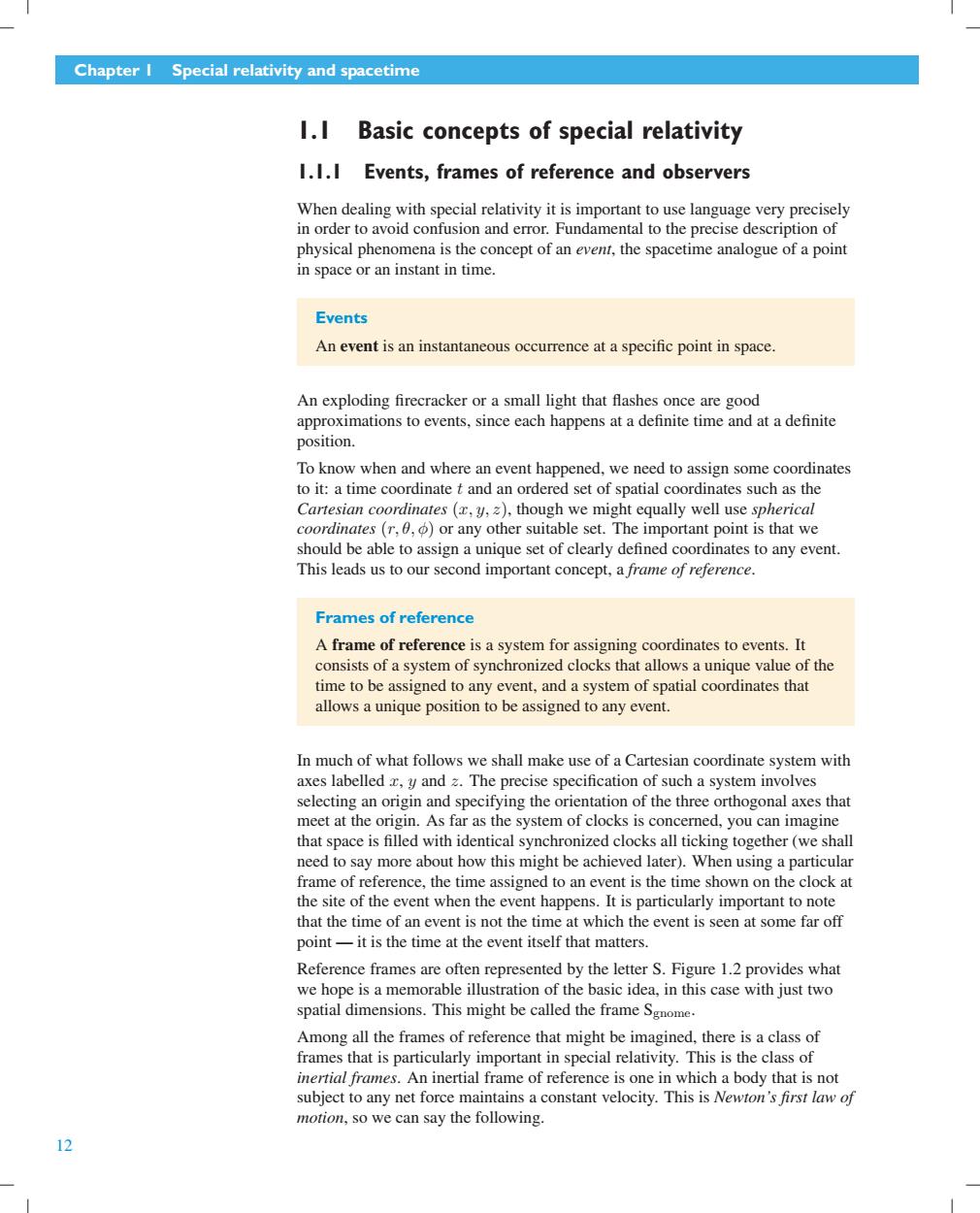
Chapter I Special relativity and spacetime 1.I Basic concepts of special relativity 1.1.I Events,frames of reference and observers When dealing with special relativity it is important to use language very precisely in order to avoid confusion and error.Fundamental to the precise description of physical phenomena is the concept of an event,the spacetime analogue of a point in space or an instant in time. Events An event is an instantaneous occurrence at a specific point in space. An exploding firecracker or a small light that flashes once are good approximations to events,since each happens at a definite time and at a definite position. To know when and where an event happened,we need to assign some coordinates to it:a time coordinate t and an ordered set of spatial coordinates such as the Cartesian coordinates (x,y,z),though we might equally well use spherical coordinates(r,0,)or any other suitable set.The important point is that we should be able to assign a unique set of clearly defined coordinates to any event. This leads us to our second important concept,a frame of reference. Frames of reference A frame of reference is a system for assigning coordinates to events.It consists of a system of synchronized clocks that allows a unique value of the time to be assigned to any event,and a system of spatial coordinates that allows a unique position to be assigned to any event. In much of what follows we shall make use of a Cartesian coordinate system with axes labelled r,y and z.The precise specification of such a system involves selecting an origin and specifying the orientation of the three orthogonal axes that meet at the origin.As far as the system of clocks is concerned,you can imagine that space is filled with identical synchronized clocks all ticking together(we shall need to say more about how this might be achieved later).When using a particular frame of reference,the time assigned to an event is the time shown on the clock at the site of the event when the event happens.It is particularly important to note that the time of an event is not the time at which the event is seen at some far off point-it is the time at the event itself that matters. Reference frames are often represented by the letter S.Figure 1.2 provides what we hope is a memorable illustration of the basic idea,in this case with just two spatial dimensions.This might be called the frame Sgnome. Among all the frames of reference that might be imagined,there is a class of frames that is particularly important in special relativity.This is the class of inertial frames.An inertial frame of reference is one in which a body that is not subject to any net force maintains a constant velocity.This is Newton's first law of motion,so we can say the following. 12
Chapter 1 Special relativity and spacetime 1.1 Basic concepts of special relativity 1.1.1 Events, frames of reference and observers When dealing with special relativity it is important to use language very precisely in order to avoid confusion and error. Fundamental to the precise description of physical phenomena is the concept of an event, the spacetime analogue of a point in space or an instant in time. Events An event is an instantaneous occurrence ataspecific point in space. An exploding firecracker or a small light that flashes once are good approximations to events, since each happens at a definite time and at a definite position. To know when and where an event happened, we need to assign some coordinates to it: a time coordinate t and an ordered set of spatial coordinates such as the Cartesian coordinates (x, y, z), though we might equally well use spherical coordinates (r, θ, φ) or any other suitable set. The important point is that we should be able to assign a unique set of clearly defined coordinates to any event. This leads us to our second important concept, a frame of reference. Frames of reference A frame of reference is a system for assigning coordinates to events. It consists of a system of synchronized clocks that allows a unique value of the time to be assigned to any event, and a system of spatial coordinates that allows a unique position to be assigned to any event. In much of what follows we shall make use of a Cartesian coordinate system with axes labelled x, y and z. The precise specification of such a system involves selecting an origin and specifying the orientation of the three orthogonal axes that meet at the origin. As far as the system of clocks is concerned, you can imagine that space is filled with identical synchronized clocks all ticking together (we shall need to say more about how this might be achieved later). When using a particular frame of reference, the time assigned to an event is the time shown on the clock at the site of the event when the event happens. It is particularly important to note that the time of an event is not the time at which the event is seen at some far off point — it is the time at the event itself that matters. Reference frames are often represented by the letter S. Figure 1.2 provides what we hope is a memorable illustration of the basic idea, in this case with just two spatial dimensions. This might be called the frame Sgnome. Among all the frames of reference that might be imagined, there is a class of frames that is particularly important in special relativity. This is the class of inertial frames. An inertial frame of reference is one in which a body that is not subject to any net force maintains a constant velocity. This is Newton’s first law of motion, so we can say the following. 12
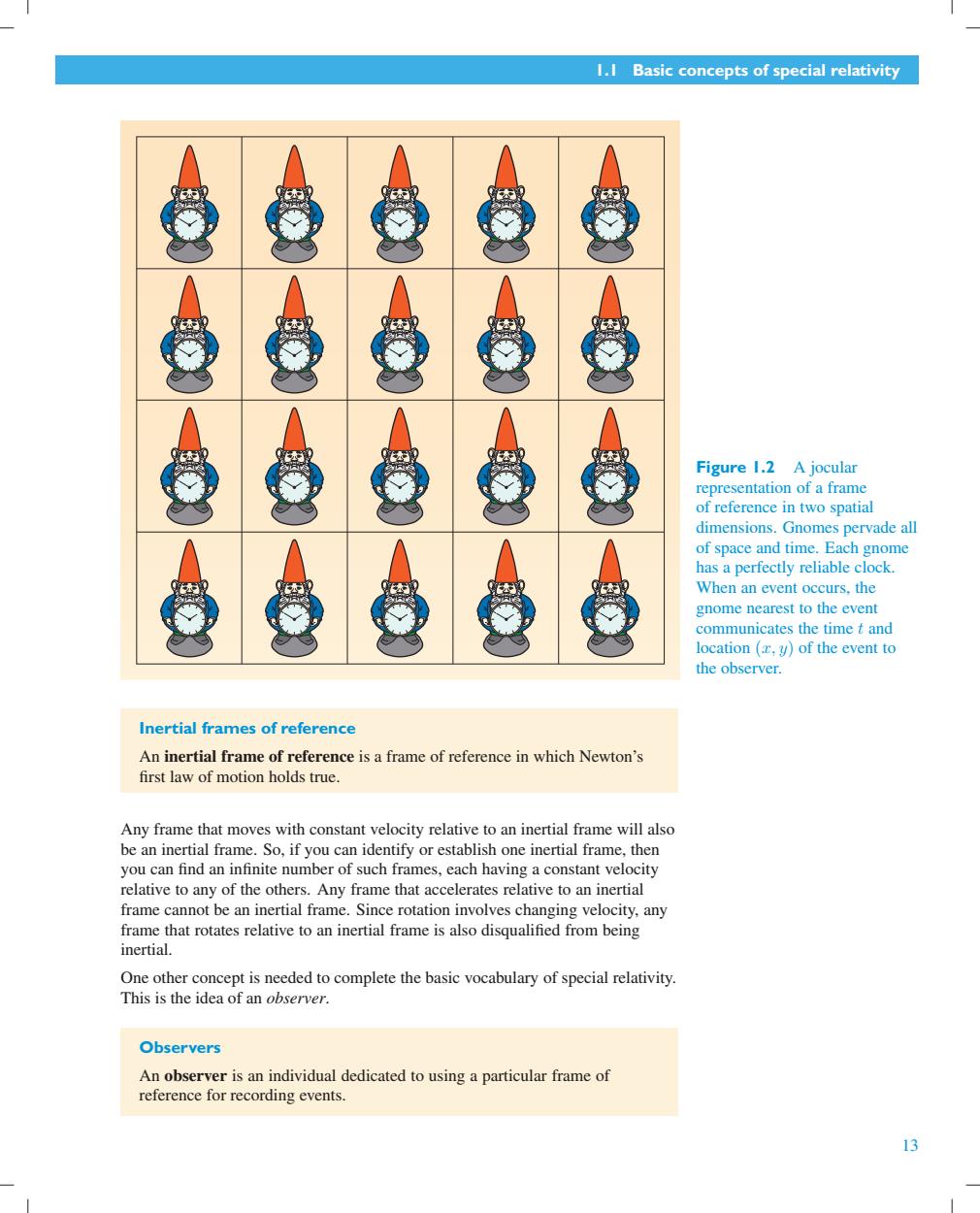
I.I Basic concepts of special relativity Figure 1.2 A jocular representation of a frame of reference in two spatial dimensions.Gnomes pervade all of space and time.Each gnome has a perfectly reliable clock. When an event occurs,the gnome nearest to the event communicates the time t and location (y)of the event to the observer. Inertial frames of reference An inertial frame of reference is a frame of reference in which Newton's first law of motion holds true. Any frame that moves with constant velocity relative to an inertial frame will also be an inertial frame.So,if you can identify or establish one inertial frame,then you can find an infinite number of such frames,each having a constant velocity relative to any of the others.Any frame that accelerates relative to an inertial frame cannot be an inertial frame.Since rotation involves changing velocity,any frame that rotates relative to an inertial frame is also disqualified from being inertial. One other concept is needed to complete the basic vocabulary of special relativity. This is the idea of an observer. Observers An observer is an individual dedicated to using a particular frame of reference for recording events. 13
1.1 Basic concepts of special relativity Figure 1.2 A jocular representation of a frame of reference in two spatial dimensions. Gnomes pervade all of space and time. Each gnome has a perfectly reliable clock. When an event occurs, the gnome nearest to the event communicates the time t and location (x, y) of the event to the observer. Inertial frames of reference An inertial frame of reference is a frame of reference in which Newton’s first law of motion holds true. Any frame that moves with constant velocity relative to an inertial frame will also be an inertial frame. So, if you can identify or establish one inertial frame, then you can find an infinite number of such frames, each having a constant velocity relative to any of the others. Any frame that accelerates relative to an inertial frame cannot be an inertial frame. Since rotation involves changing velocity, any frame that rotates relative to an inertial frame is also disqualified from being inertial. One other concept is needed to complete the basic vocabulary of special relativity. This is the idea of an observer. Observers An observer is an individual dedicated to using a particular frame of reference for recording events. 13
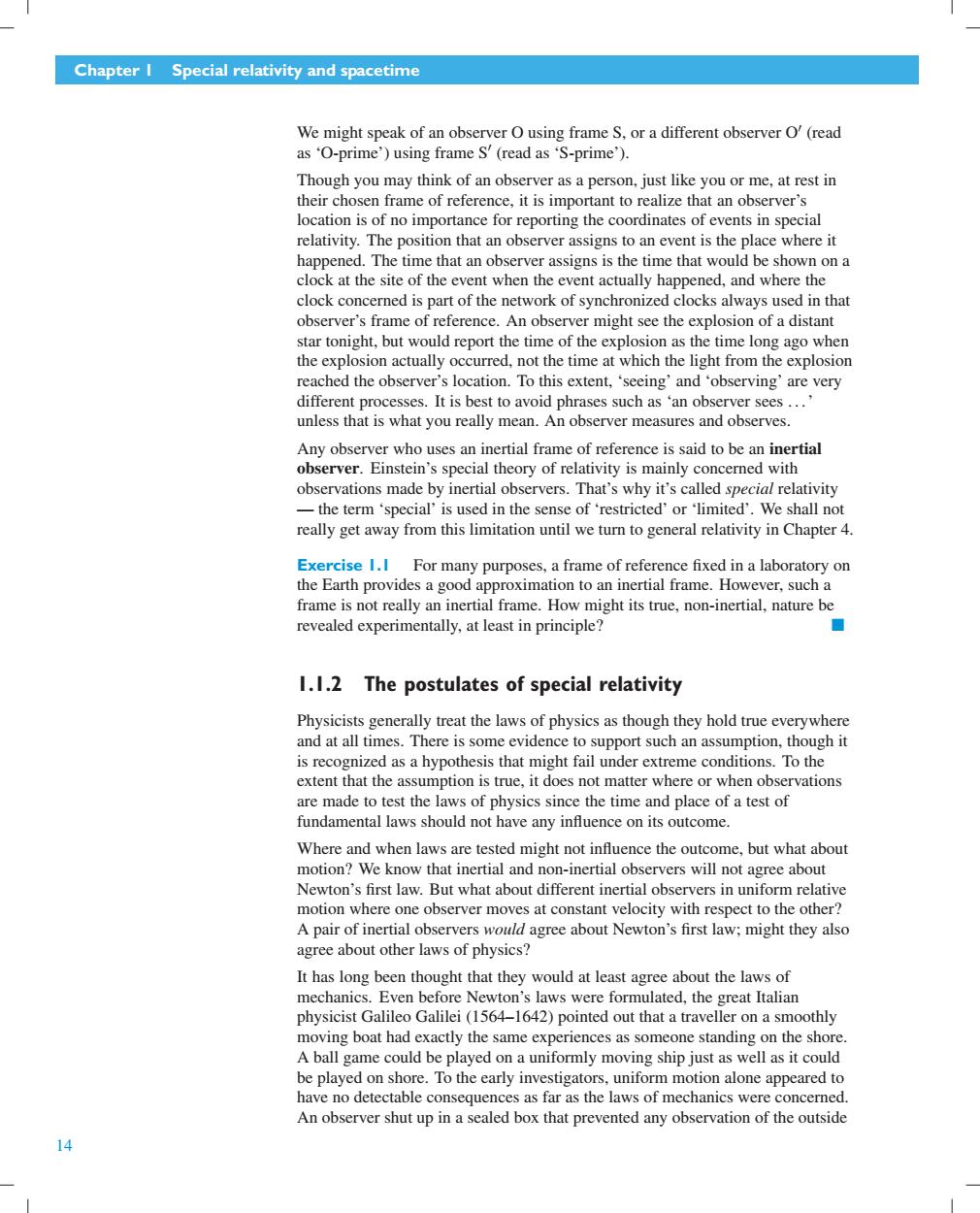
Chapter I Special relativity and spacetime We might speak of an observer O using frame S,or a different observer O'(read as 'O-prime')using frame S'(read as 'S-prime'). Though you may think of an observer as a person,just like you or me,at rest in their chosen frame of reference,it is important to realize that an observer's location is of no importance for reporting the coordinates of events in special relativity.The position that an observer assigns to an event is the place where it happened.The time that an observer assigns is the time that would be shown on a clock at the site of the event when the event actually happened,and where the clock concerned is part of the network of synchronized clocks always used in that observer's frame of reference.An observer might see the explosion of a distant star tonight,but would report the time of the explosion as the time long ago when the explosion actually occurred,not the time at which the light from the explosion reached the observer's location.To this extent,'seeing'and'observing'are very different processes.It is best to avoid phrases such as 'an observer sees... unless that is what you really mean.An observer measures and observes. Any observer who uses an inertial frame of reference is said to be an inertial observer.Einstein's special theory of relativity is mainly concerned with observations made by inertial observers.That's why it's called special relativity -the term 'special'is used in the sense of'restricted'or 'limited'.We shall not really get away from this limitation until we turn to general relativity in Chapter 4. Exercise 1.I For many purposes,a frame of reference fixed in a laboratory on the Earth provides a good approximation to an inertial frame.However,such a frame is not really an inertial frame.How might its true,non-inertial,nature be revealed experimentally,at least in principle? ■ 1.1.2 The postulates of special relativity Physicists generally treat the laws of physics as though they hold true everywhere and at all times.There is some evidence to support such an assumption,though it is recognized as a hypothesis that might fail under extreme conditions.To the extent that the assumption is true,it does not matter where or when observations are made to test the laws of physics since the time and place of a test of fundamental laws should not have any influence on its outcome. Where and when laws are tested might not influence the outcome,but what about motion?We know that inertial and non-inertial observers will not agree about Newton's first law.But what about different inertial observers in uniform relative motion where one observer moves at constant velocity with respect to the other? A pair of inertial observers would agree about Newton's first law;might they also agree about other laws of physics? It has long been thought that they would at least agree about the laws of mechanics.Even before Newton's laws were formulated,the great Italian physicist Galileo Galilei (1564-1642)pointed out that a traveller on a smoothly moving boat had exactly the same experiences as someone standing on the shore. A ball game could be played on a uniformly moving ship just as well as it could be played on shore.To the early investigators,uniform motion alone appeared to have no detectable consequences as far as the laws of mechanics were concerned. An observer shut up in a sealed box that prevented any observation of the outside 14
Chapter 1 Special relativity and spacetime We might speak of an observer O using frame S, or a different observer O % (read as ‘O-prime’) using frame S % (read as ‘S-prime’). Though you may think of an observer as a person, just like you or me, at rest in their chosen frame of reference, it is important to realize that an observer’s location is of no importance for reporting the coordinates of events in special relativity. The position that an observer assigns to an event is the place where it happened. The time that an observer assigns is the time that would be shown on a clock at the site of the event when the event actually happened, and where the clock concerned is part of the network of synchronized clocks always used in that observer’s frame of reference. An observer might see the explosion of a distant star tonight, but would report the time of the explosion as the time long ago when the explosion actually occurred, not the time at which the light from the explosion reached the observer’s location. To this extent, ‘seeing’ and ‘observing’ are very different processes. It is best to avoid phrases such as ‘an observer sees ...’ unless that is what you really mean. An observer measures and observes. Any observer who uses an inertial frame of reference is said to be an inertial observer. Einstein’s special theory of relativity is mainly concerned with observations made by inertial observers. That’s why it’s called special relativity — the term ‘special’ is used in the sense of ‘restricted’ or ‘limited’. We shall not really get away from this limitation until we turn to general relativity in Chapter 4. Exercise 1.1 For many purposes, a frame of reference fixed in a laboratory on the Earth provides a good approximation to an inertial frame. However, such a frame is not really an inertial frame. How might its true, non-inertial, nature be revealed experimentally, at least in principle? ■ 1.1.2 The postulates of special relativity Physicists generally treat the laws of physics as though they hold true everywhere and at all times. There is some evidence to support such an assumption, though it is recognized as a hypothesis that might fail under extreme conditions. To the extent that the assumption is true, it does not matter where or when observations are made to test the laws of physics since the time and place of a test of fundamental laws should not have any influence on its outcome. Where and when laws are tested might not influence the outcome, but what about motion? We know that inertial and non-inertial observers will not agree about Newton’s first law. But what about different inertial observers in uniform relative motion where one observer moves at constant velocity with respect to the other? A pair of inertial observers would agree about Newton’s first law; might they also agree about other laws of physics? It has long been thought that they would at least agree about the laws of mechanics. Even before Newton’s laws were formulated, the great Italian physicist Galileo Galilei (1564–1642) pointed out that a traveller on a smoothly moving boat had exactly the same experiences as someone standing on the shore. A ball game could be played on a uniformly moving ship just as well as it could be played on shore. To the early investigators, uniform motion alone appeared to have no detectable consequences as far as the laws of mechanics were concerned. An observer shut up in a sealed box that prevented any observation of the outside 14
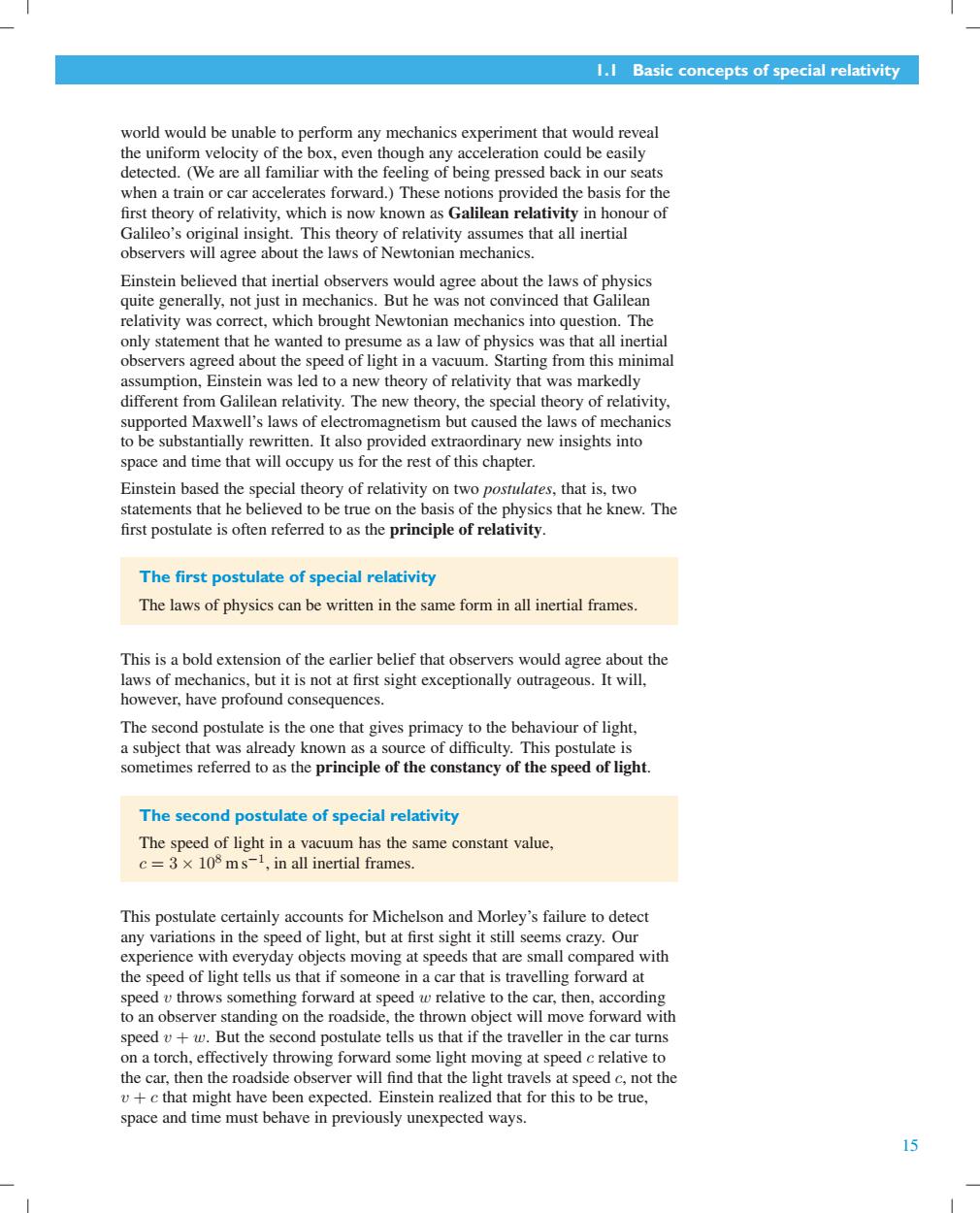
.1 Basic concepts of special relativity world would be unable to perform any mechanics experiment that would reveal the uniform velocity of the box,even though any acceleration could be easily detected.(We are all familiar with the feeling of being pressed back in our seats when a train or car accelerates forward.)These notions provided the basis for the first theory of relativity,which is now known as Galilean relativity in honour of Galileo's original insight.This theory of relativity assumes that all inertial observers will agree about the laws of Newtonian mechanics. Einstein believed that inertial observers would agree about the laws of physics quite generally,not just in mechanics.But he was not convinced that Galilean relativity was correct,which brought Newtonian mechanics into question.The only statement that he wanted to presume as a law of physics was that all inertial observers agreed about the speed of light in a vacuum.Starting from this minimal assumption,Einstein was led to a new theory of relativity that was markedly different from Galilean relativity.The new theory,the special theory of relativity, supported Maxwell's laws of electromagnetism but caused the laws of mechanics to be substantially rewritten.It also provided extraordinary new insights into space and time that will occupy us for the rest of this chapter. Einstein based the special theory of relativity on two postulates,that is,two statements that he believed to be true on the basis of the physics that he knew.The first postulate is often referred to as the principle of relativity. The first postulate of special relativity The laws of physics can be written in the same form in all inertial frames. This is a bold extension of the earlier belief that observers would agree about the laws of mechanics,but it is not at first sight exceptionally outrageous.It will, however,have profound consequences. The second postulate is the one that gives primacy to the behaviour of light, a subject that was already known as a source of difficulty.This postulate is sometimes referred to as the principle of the constancy of the speed of light. The second postulate of special relativity The speed of light in a vacuum has the same constant value, c=3×l0的ms-1,in all inertial frames. This postulate certainly accounts for Michelson and Morley's failure to detect any variations in the speed of light,but at first sight it still seems crazy.Our experience with everyday objects moving at speeds that are small compared with the speed of light tells us that if someone in a car that is travelling forward at speed v throws something forward at speed w relative to the car,then,according to an observer standing on the roadside,the thrown object will move forward with speed v+w.But the second postulate tells us that if the traveller in the car turns on a torch,effectively throwing forward some light moving at speed c relative to the car,then the roadside observer will find that the light travels at speed c,not the v+c that might have been expected.Einstein realized that for this to be true, space and time must behave in previously unexpected ways. 15
1.1 Basic concepts of special relativity world would be unable to perform any mechanics experiment that would reveal the uniform velocity of the box, even though any acceleration could be easily detected. (We are all familiar with the feeling of being pressed back in our seats when a train or car accelerates forward.) These notions provided the basis for the first theory of relativity, which is now known as Galilean relativity in honour of Galileo’s original insight. This theory of relativity assumes that all inertial observers will agree about the laws of Newtonian mechanics. Einstein believed that inertial observers would agree about the laws of physics quite generally, not just in mechanics. But he was not convinced that Galilean relativity was correct, which brought Newtonian mechanics into question. The only statement that he wanted to presume as a law of physics was that all inertial observers agreed about the speed of light in a vacuum. Starting from this minimal assumption, Einstein was led to a new theory of relativity that was markedly different from Galilean relativity. The new theory, the special theory of relativity, supported Maxwell’s laws of electromagnetism but caused the laws of mechanics to be substantially rewritten. It also provided extraordinary new insights into space and time that will occupy us for the rest of this chapter. Einstein based the special theory of relativity on two postulates, that is, two statements that he believed to be true on the basis of the physics that he knew. The first postulate is often referred to as the principle of relativity. The first postulate of special relativity The laws of physics can be written in the same form in all inertial frames. This is a bold extension of the earlier belief that observers would agree about the laws of mechanics, but it is not at first sight exceptionally outrageous. It will, however, have profound consequences. The second postulate is the one that gives primacy to the behaviour of light, a subject that was already known as a source of difficulty. This postulate is sometimes referred to as the principle of the constancy of the speed of light. The second postulate of special relativity The speed of light in a vacuum has the same constant value, c = 3 × 108 m s−1 , in all inertial frames. This postulate certainly accounts for Michelson and Morley’s failure to detect any variations in the speed of light, but at first sight it still seems crazy. Our experience with everyday objects moving at speeds that are small compared with the speed of light tells us that if someone in a car that is travelling forward at speed v throws something forward at speed w relative to the car, then, according to an observer standing on the roadside, the thrown object will move forward with speed v + w. But the second postulate tells us that if the traveller in the car turns on a torch, effectively throwing forward some light moving at speed c relative to the car, then the roadside observer will find that the light travels at speed c, not the v + c that might have been expected. Einstein realized that for this to be true, space and time must behave in previously unexpected ways. 15
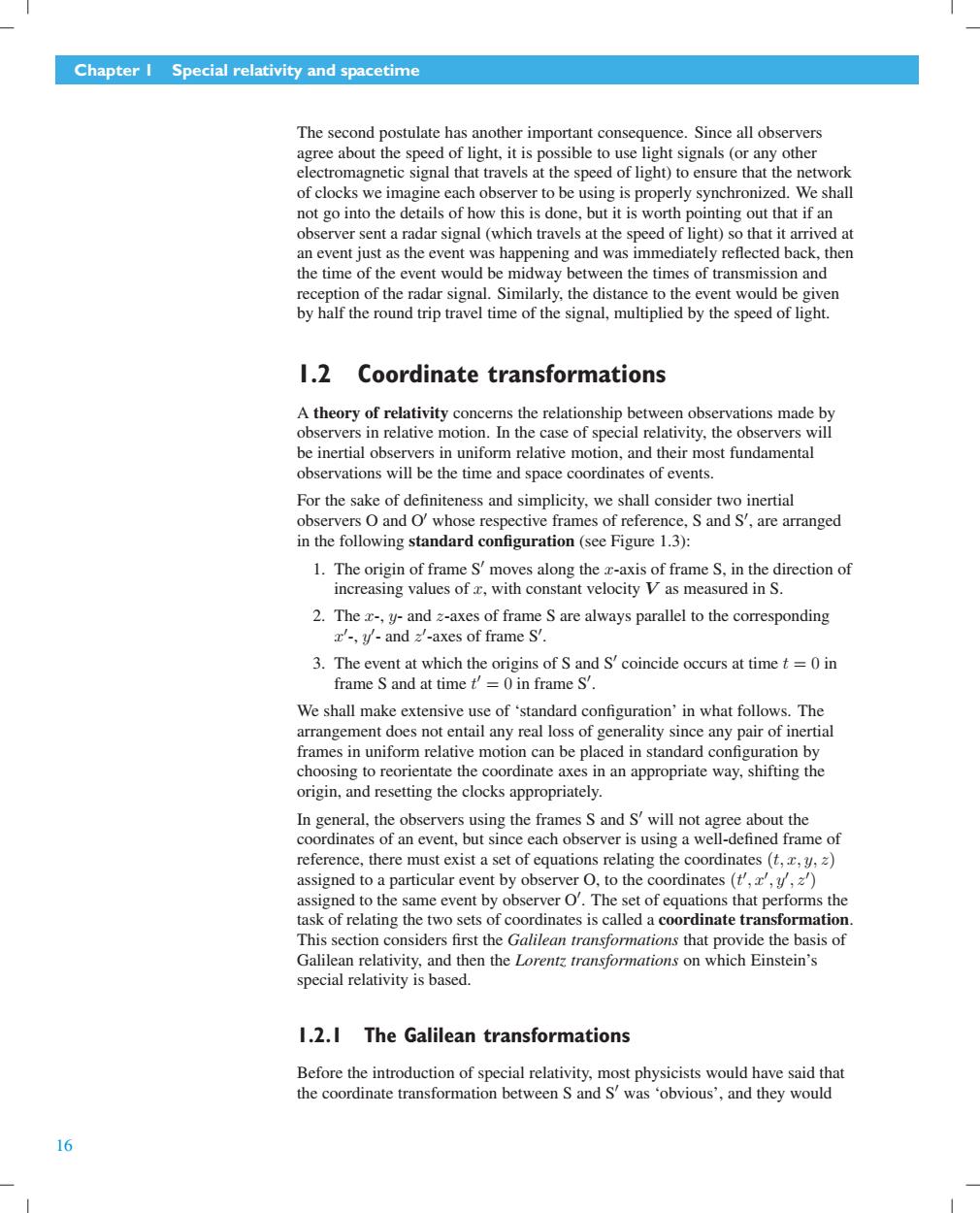
Chapter I Special relativity and spacetime The second postulate has another important consequence.Since all observers agree about the speed of light,it is possible to use light signals(or any other electromagnetic signal that travels at the speed of light)to ensure that the network of clocks we imagine each observer to be using is properly synchronized.We shall not go into the details of how this is done,but it is worth pointing out that if an observer sent a radar signal (which travels at the speed of light)so that it arrived at an event just as the event was happening and was immediately reflected back,then the time of the event would be midway between the times of transmission and reception of the radar signal.Similarly,the distance to the event would be given by half the round trip travel time of the signal,multiplied by the speed of light. 1.2 Coordinate transformations A theory of relativity concerns the relationship between observations made by observers in relative motion.In the case of special relativity,the observers will be inertial observers in uniform relative motion,and their most fundamental observations will be the time and space coordinates of events. For the sake of definiteness and simplicity,we shall consider two inertial observers O and O'whose respective frames of reference,S and S',are arranged in the following standard configuration(see Figure 1.3): 1.The origin of frame S'moves along the c-axis of frame S,in the direction of increasing values of r,with constant velocity V as measured in S. 2.The x-,y-and z-axes of frame S are always parallel to the corresponding x'-,y-and z'-axes of frame S'. 3.The event at which the origins of S and S'coincide occurs at time t =0 in frame S and at time t'=0 in frame S'. We shall make extensive use of 'standard configuration'in what follows.The arrangement does not entail any real loss of generality since any pair of inertial frames in uniform relative motion can be placed in standard configuration by choosing to reorientate the coordinate axes in an appropriate way,shifting the origin,and resetting the clocks appropriately. In general,the observers using the frames S and S'will not agree about the coordinates of an event,but since each observer is using a well-defined frame of reference,there must exist a set of equations relating the coordinates (t,y,2) assigned to a particular event by observer O,to the coordinates (t',,,2) assigned to the same event by observer O'.The set of equations that performs the task of relating the two sets of coordinates is called a coordinate transformation. This section considers first the Galilean transformations that provide the basis of Galilean relativity,and then the Lorentz transformations on which Einstein's special relativity is based. 1.2.I The Galilean transformations Before the introduction of special relativity,most physicists would have said that the coordinate transformation between S and S'was 'obvious',and they would 16
Chapter 1 Special relativity and spacetime The second postulate has another important consequence. Since all observers agree about the speed of light, it is possible to use light signals (or any other electromagnetic signal that travels at the speed of light) to ensure that the network of clocks we imagine each observer to be using is properly synchronized. We shall not go into the details of how this is done, but it is worth pointing out that if an observer sentaradar signal (which travels at the speed of light) so that it arrived at an event just as the event was happening and was immediately reflected back, then the time of the event would be midway between the times of transmission and reception of the radar signal. Similarly, the distance to the event would be given by half the round trip travel time of the signal, multiplied by the speed of light. 1.2 Coordinate transformations A theory of relativity concerns the relationship between observations made by observers in relative motion. In the case of special relativity, the observers will be inertial observers in uniform relative motion, and their most fundamental observations will be the time and space coordinates of events. For the sake of definiteness and simplicity, we shall consider two inertial observers O and O % whose respective frames of reference, S and S % , are arranged in the following standard configuration (see Figure 1.3): 1. The origin of frame S % moves along the x-axis of frame S, in the direction of increasing values of x, with constant velocity V as measured in S. 2. The x-, y- and z-axes of frame S are always parallel to the corresponding x % -, y % - and z % -axes of frame S% . 3. The event at which the origins of S and S % coincide occurs at time t = 0 in frame S and at time t % = 0 in frame S % . We shall make extensive use of ‘standard configuration’ in what follows. The arrangement does not entail any real loss of generality since any pair of inertial frames in uniform relative motion can be placed in standard configuration by choosing to reorientate the coordinate axes in an appropriate way, shifting the origin, and resetting the clocks appropriately. In general, the observers using the frames S and S% will not agree about the coordinates of an event, but since each observer is using a well-defined frame of reference, there must exist a set of equations relating the coordinates (t, x, y, z) assigned to a particular event by observer O, to the coordinates (t % , x% , y% , z% ) assigned to the same event by observer O% . The set of equations that performs the task of relating the two sets of coordinates is called a coordinate transformation. This section considers first the Galilean transformations that provide the basis of Galilean relativity, and then the Lorentz transformations on which Einstein’s special relativity is based. 1.2.1 The Galilean transformations Before the introduction of special relativity, most physicists would have said that the coordinate transformation between S and S % was ‘obvious’, and they would 16
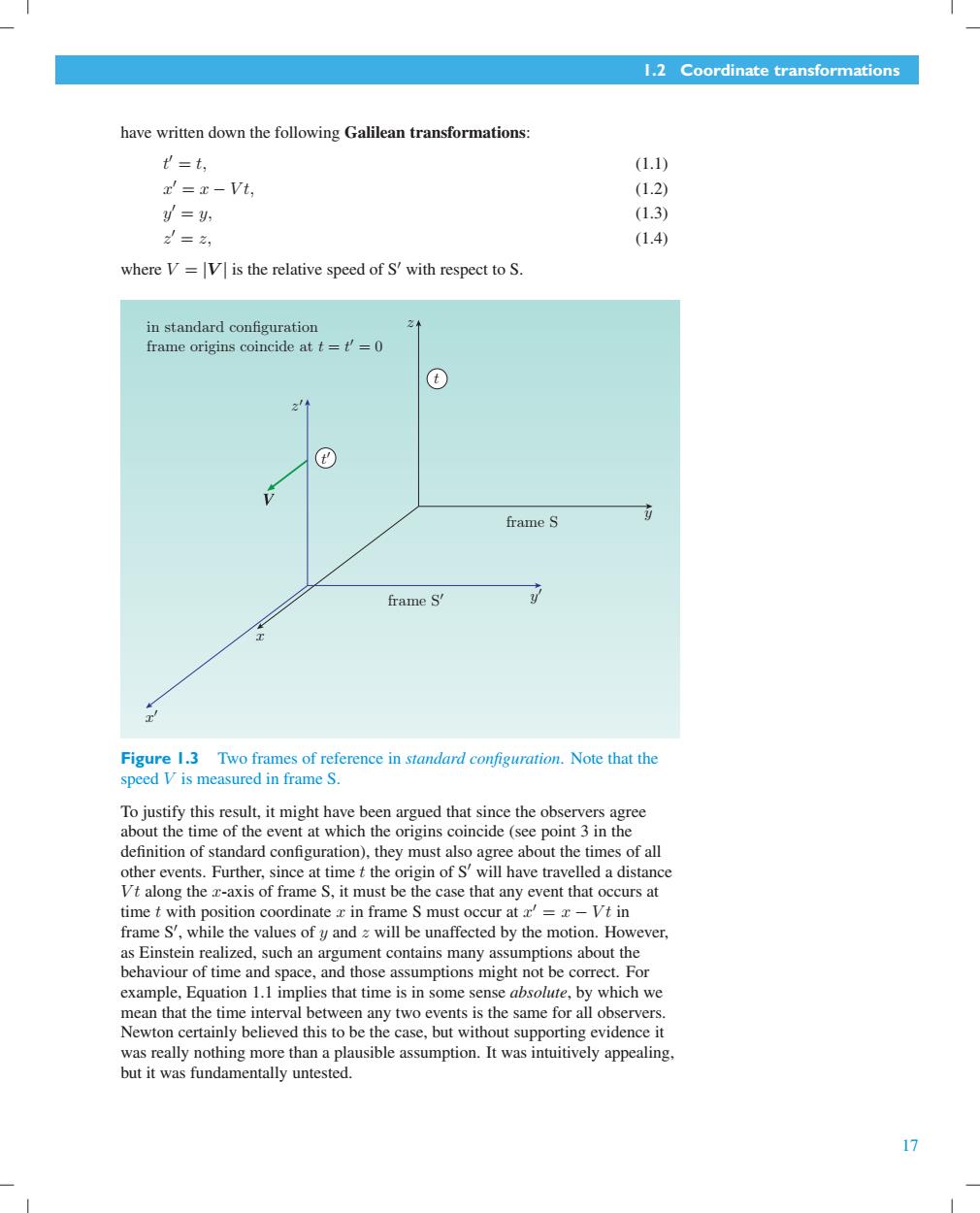
1.2 Coordinate transformations have written down the following Galilean transformations: t=t, (1.1) x'=x-Vt, (1.2) =y, (1.3) 2=2, (1.4) where V=V is the relative speed of S'with respect to S. in standard configuration 2 frame origins coincide at t=t'=0 t frame S frame S' Figure 1.3 Two frames of reference in standard configuration.Note that the speed V is measured in frame S. To justify this result,it might have been argued that since the observers agree about the time of the event at which the origins coincide(see point 3 in the definition of standard configuration),they must also agree about the times of all other events.Further,since at time t the origin of S'will have travelled a distance Vt along the z-axis of frame S,it must be the case that any event that occurs at time t with position coordinate x in frame S must occur at '=x-Vt in frame S',while the values of y and z will be unaffected by the motion.However, as Einstein realized,such an argument contains many assumptions about the behaviour of time and space,and those assumptions might not be correct.For example,Equation 1.1 implies that time is in some sense absolute,by which we mean that the time interval between any two events is the same for all observers. Newton certainly believed this to be the case,but without supporting evidence it was really nothing more than a plausible assumption.It was intuitively appealing, but it was fundamentally untested. 17
1.2 Coordinate transformations have written down the following Galilean transformations: t % = t, (1.1) x % = x − V t, (1.2) y % = y, (1.3) z % = z, (1.4) where V = |V | is the relative speed of S % with respect to S. frame S frame S" in standard configuration frame origins coincide at t = t " = 0 x y z t x " y " z " t " Figure 1.3 Two frames of reference in standard configuration. Note that the speed V is measured in frame S. To justify this result, it might have been argued that since the observers agree about the time of the event at which the origins coincide (see point 3 in the definition of standard configuration), they must also agree about the times of all other events. Further, since at time t the origin of S% will have travelled a distance V t along the x-axis of frame S, it must be the case that any event that occurs at time t with position coordinate x in frame S must occur at x % = x − V t in frame S % , while the values of y and z will be unaffected by the motion. However, as Einstein realized, such an argument contains many assumptions about the behaviour of time and space, and those assumptions might not be correct. For example, Equation 1.1 implies that time is in some sense absolute, by which we mean that the time interval between any two events is the same for all observers. Newton certainly believed this to be the case, but without supporting evidence it was really nothing more than a plausible assumption. It was intuitively appealing, but it was fundamentally untested. 17
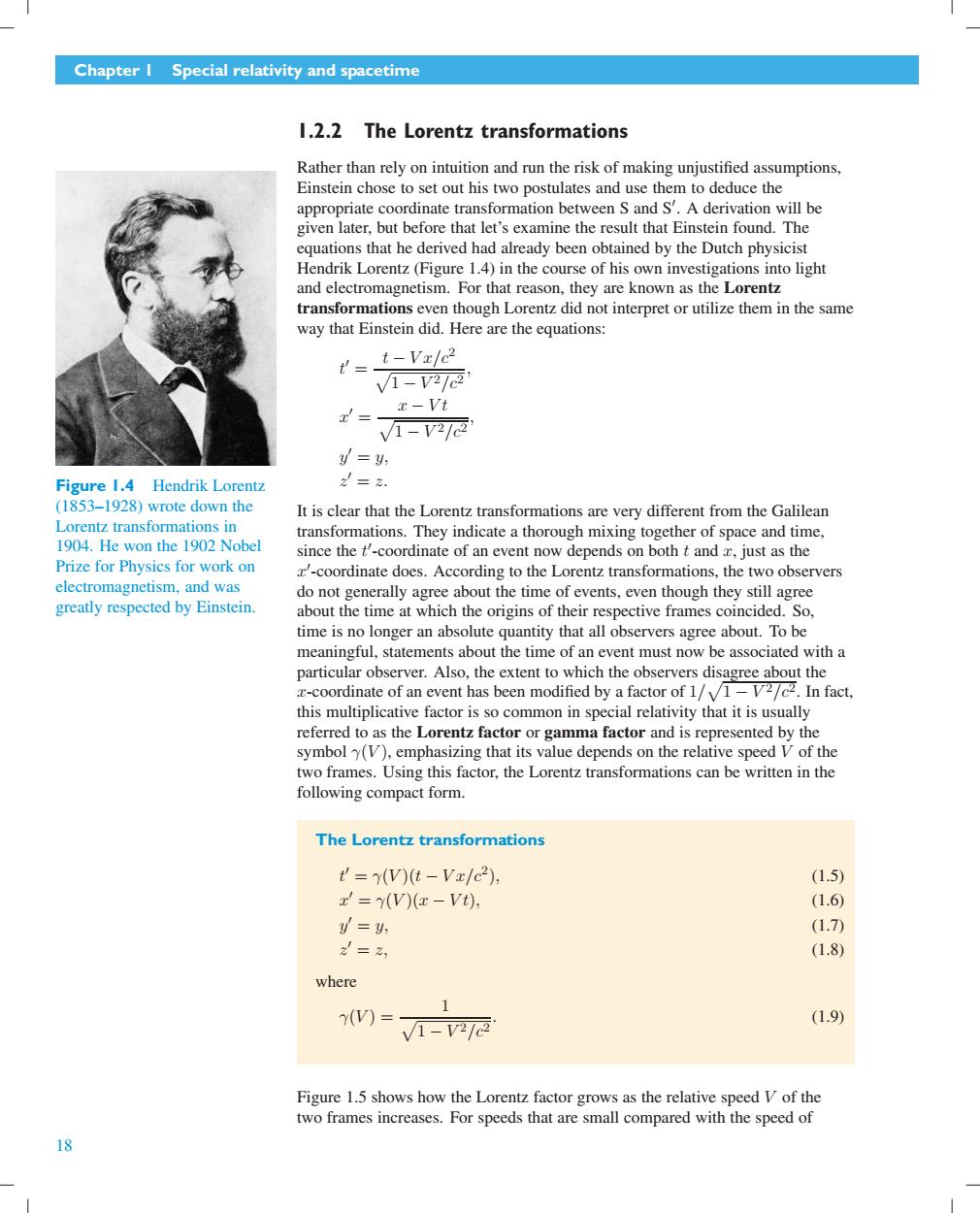
Chapter I Special relativity and spacetime 1.2.2 The Lorentz transformations Rather than rely on intuition and run the risk of making unjustified assumptions, Einstein chose to set out his two postulates and use them to deduce the appropriate coordinate transformation between S and S'.A derivation will be given later,but before that let's examine the result that Einstein found.The equations that he derived had already been obtained by the Dutch physicist Hendrik Lorentz(Figure 1.4)in the course of his own investigations into light and electromagnetism.For that reason,they are known as the Lorentz transformations even though Lorentz did not interpret or utilize them in the same way that Einstein did.Here are the equations: t=_ t-Vzlc2 vV1-V2/c21 t= x-Vt V1-2/21 =y, Figure 1.4 Hendrik Lorentz 之=. (1853-1928)wrote down the It is clear that the Lorentz transformations are very different from the Galilean Lorentz transformations in transformations.They indicate a thorough mixing together of space and time, 1904.He won the 1902 Nobel since the t'-coordinate of an event now depends on both t and x,just as the Prize for Physics for work on x'-coordinate does.According to the Lorentz transformations,the two observers electromagnetism,and was do not generally agree about the time of events,even though they still agree greatly respected by Einstein. about the time at which the origins of their respective frames coincided.So, time is no longer an absolute quantity that all observers agree about.To be meaningful,statements about the time of an event must now be associated with a particular observer.Also,the extent to which the observers disagree about the x-coordinate of an event has been modified by a factor of 1/1-V2/c2.In fact, this multiplicative factor is so common in special relativity that it is usually referred to as the Lorentz factor or gamma factor and is represented by the symbol (V),emphasizing that its value depends on the relative speed V of the two frames.Using this factor,the Lorentz transformations can be written in the following compact form. The Lorentz transformations t=7(V)(t-Vz/c2), (1.5) I'=y(v)(x-Vt), (1.6 y=y, (1.7) 之=, (1.8) where 1 y(V)= (1.9) /1-2/c2 Figure 1.5 shows how the Lorentz factor grows as the relative speed V of the two frames increases.For speeds that are small compared with the speed of 18
Chapter 1 Special relativity and spacetime 1.2.2 The Lorentz transformations Rather than rely on intuition and run the risk of making unjustified assumptions, Einstein chose to set out his two postulates and use them to deduce the appropriate coordinate transformation between S and S % . A derivation will be given later, but before that let’s examine the result that Einstein found. The equations that he derived had already been obtained by the Dutch physicist Hendrik Lorentz (Figure 1.4) in the course of his own investigations into light and electromagnetism. For that reason, they are known as the Lorentz transformations even though Lorentz did not interpret or utilize them in the same way that Einstein did. Here are the equations: Figure 1.4 Hendrik Lorentz (1853–1928) wrote down the Lorentz transformations in 1904. He won the 1902 Nobel Prize for Physics for work on electromagnetism, and was greatly respected by Einstein. t % = t − V x/c2 - 1 − V 2/c2 , x % = x − V t - 1 − V 2/c2 , y % = y, z % = z. It is clear that the Lorentz transformations are very different from the Galilean transformations. They indicate a thorough mixing together of space and time, since the t % -coordinate of an event now depends on both t and x, just as the x % -coordinate does. According to the Lorentz transformations, the two observers do not generally agree about the time of events, even though they still agree about the time at which the origins of their respective frames coincided. So, time is no longer an absolute quantity that all observers agree about. To be meaningful, statements about the time of an event must now be associated with a particular observer. Also, the extent to which the observers disagree about the x-coordinate of an event has been modified by a factor of 1/ - 1 − V 2/c2 . In fact, this multiplicative factor is so common in special relativity that it is usually referred to as the Lorentz factor or gamma factor and is represented by the symbol γ(V ), emphasizing that its value depends on the relative speed V of the two frames. Using this factor, the Lorentz transformations can be written in the following compact form. The Lorentz transformations t % = γ(V )(t − V x/c2 ), (1.5) x % = γ(V )(x − V t), (1.6) y % = y, (1.7) z % = z, (1.8) where γ(V ) = 1 - 1 − V 2/c2 . (1.9) Figure 1.5 shows how the Lorentz factor grows as the relative speed V of the two frames increases. For speeds that are small compared with the speed of 18